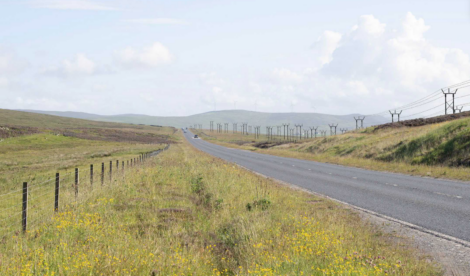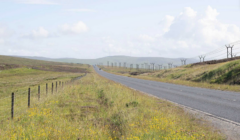Environment / Peatland restoration and tree planting planned to offset power line project biodiversity loss
PEAT RESTORATION and tree planting could be carried out by the developer of plans for new overhead and underground power lines in Shetland’s Central Mainland to offset the biodiversity loss caused by the project.
Developer SSEN Transmission said among its plans is a proposal for a restoration scheme covering around 28 hectares at Girlsta on damaged peatland, which would include the planting of native trees and shrubs.
The hope is to achieve biodiversity gain rather than securing just no net loss.
Biodiversity is a term used to describe the variety of all life on Earth, including plants and animals. Peatland includes several habitats and species that are important for biodiversity.
It follows a question from Tingwall, Whiteness and Weisdale Community Council about how the proposed overhead power lines will run through the middle of an existing Shetland Amenity Trust peat restoration project at Girlsta.
SSEN has applied for consent for two 132 kV overhead lines running in parallel over a 11.5km distance from near Lerwick to Kergord.
There will also be a similar length of lines buried underground for reasons including engineering constraints, avoiding other infrastructure and the suitability of land.
The biodiversity plans have been developed to take into account impacts from both the underground and overhead cable work. The potential habitats affected by the project are mainly grassland and heath, with some small areas of permanent peatland loss.
The project aims to link Lerwick and Kergord as part of Shetland’s new energy set-up once the isles are connected to the national grid via a subsea transmission link in 2024.
The new lines are required to connect a planned grid supply point in Gremista, and the consented Mossy Hill wind farm outside of Lerwick, to a new substation in Kergord. This will allow Shetland to connect to the UK’s national grid for the first time.
Become a member of Shetland News
The overhead lines will predominantly follow the route of the A970, from Veensgarth to near Sandwater. They will be different than Shetland’s existing power lines; the proposed H pole is based on a trident design.
The Scottish Government’s Energy Consents Unit is still to make a final planning decision on the project. The sections where line is put underground do not require planning consent.
Tingwall, Whiteness and Weisdale Community Council has written to the unit in objection the plans, with members keen to see more line buried underground in reduce the impact on residents.
Regarding the existing peat restoration efforts in Girlsta, SSEN’s town planning specialist Murray Agnew said in response that it has consulted with Shetland Amenity Trust throughout the development of the project’s design.
He said the contractor would put in place control and mitigation measures to “ensure that reinstatement is as effective as possible”.
Agnew added that the proposed new 132kV overhead lines have “substantially reduced direct impacts on peatland when compared to the impacts caused by burial of two new 132kV underground cable circuits along the enter alignment”.
He said: “There would be insufficient space to bury two 132kV circuits along the road side for example, and the alternative would be to bury the cables in peatland which would significantly increase the environmental impact of the development.
“In addition, we are working with a local landowner and Shetland Amenity Trust to secure a location for peatland restoration and tree planting to compensate for biodiversity loss caused by the development as a whole.”
In a statement to Shetland News, a spokesperson for SSEN Transmission said: “As a business, our biodiversity net gain strategy ensures that as a minimum we deliver no biodiversity net loss on all of our new projects.
“Put simply, this means we’ll leave biodiversity in a better place than when we found it.
“This means that at our proposed Gremista connection project, although we have robust plans in place to ensure a high standard of mitigation during construction, we have made sure to account for any residual impact to habitats which are disturbed during our work.
“Our approach to biodiversity net gain means that even these relatively short-term effects on biodiversity are accounted for and additional areas of habitat are proposed to be enhanced to ensure the project has positive effects for biodiversity.”
In response to a plea for lines to be buried, Agnew said that 11.4km of existing distribution lines along the route of the new circuits are to be buried as a result of the development – potentially improving views for some residents.
There is also said to be a substation additional cost to burying lines, with SSEN reminding the community council that under licence obligations it is required to provide a “cost-effective solution”.
If the project is given consent, helicopters will fly in materials to site to limit the amount of vehicles crossing terrain.
Campaign groups Sustainable Shetland and Save Shetland have both objected to the overhead line plans.
Calling for the lines to be placed underground, Sustainable Shetland chairman Frank Hay said in his objection letter: “It is bad enough having to put up with the detrimental effects on the landscape of the Viking Windfarm without the added blot on the landscape that these pylons undoubtedly will be.”
Meanwhile Save Shetland’s Ernie Ramaker said in his letter of objection: “We would argue that proposed overhead configuration is totally unsuited for a small island which has already been severely impacted by this project, and that financial consideration should not be prioritised over the wellbeing of those directly affected.”
Become a member of Shetland News
Shetland News is asking its readers to consider paying for membership to get additional perks:
- Removal of third-party ads;
- Bookmark posts to read later;
- Exclusive curated weekly newsletter;
- Hide membership messages;
- Comments open for discussion.
If you appreciate what we do and feel strongly about impartial local journalism, then please become a member of Shetland News by either making a single payment, or setting up a monthly, quarterly or yearly subscription.











